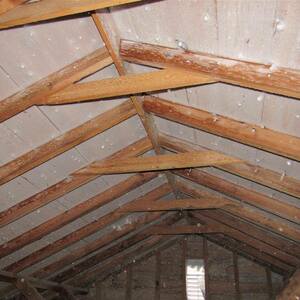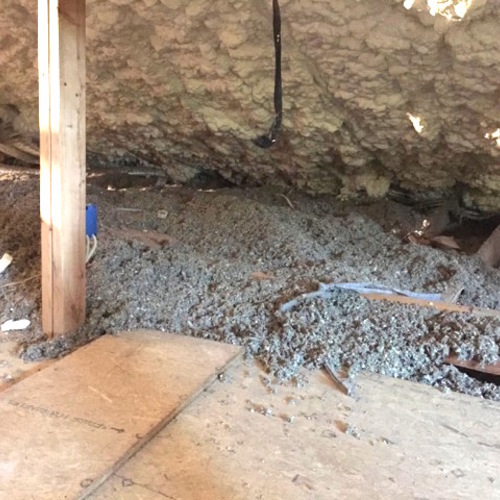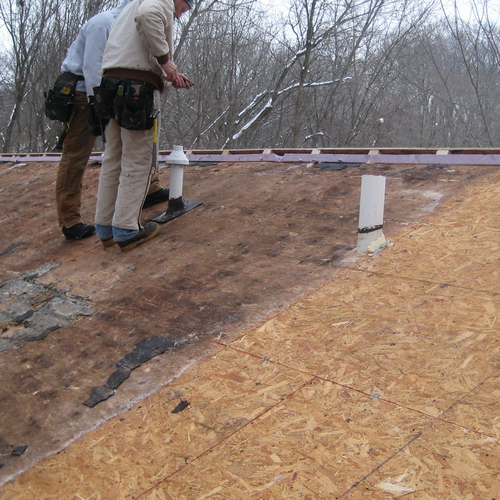
Attics come in many shapes and sizes, but they are either conditioned or unconditioned. That is, they are insulated and heated like the rest of the house and can be considered conditioned space, or they are designed to allow the free circulation of outdoor air and become unconditioned spaces.
Is one option better than the other? That’s what Rus Pearson would like to know.
“Some say spray the roof deck, allowing the attic air to become conditioned, which is great for the [heating and cooling] ducts in the attic,” Pearson writes in a Q&A post at Green Building Advisor. “Others say spray the attic side or the ceiling to allow the attic to vent. I don’t understand this one since the attic air is now unconditioned air and the ducts a have only a wrap of insulation… I’m confused.”
Pearson’s question looks straightforward. But the ensuing discussion, the topic of this Q&A Spotlight, quickly turns to the merits of spray foam insulation, which is often used as an air and vapor barrier, as well as insulation.
First, the basics
A key consideration is whether, as Pearson suggests, there will be heating and cooling ducts in the attic. That’s not uncommon, and in some homes, air handlers and other HVAC equipment also may be located there as well.
“If there are any ducts in your attic, it’s always better to have the second kind of attic — an unvented conditioned attic — so you aren’t wasting heat during the winter or losing cool, conditioned air from your ducts during the summer,” says GBA senior editor Martin Holladay.
The topic has been covered at GBA in the past (for a couple of articles on this topic, use the links listed in…
Weekly Newsletter
Get building science and energy efficiency advice, plus special offers, in your inbox.

This article is only available to GBA Prime Members
Sign up for a free trial and get instant access to this article as well as GBA’s complete library of premium articles and construction details.
Start Free TrialAlready a member? Log in















6 Comments
Not so fast, my friends... (as Lee Corso says)
Issues I didn’t hear in these discussions are house designs (style and size) and labor. I try to work with my clients on which attic system to use, as long as the HVAC and the duct system is in conditioned space or encapsulated. Sometimes the design of the house, especially if it’s a large house, with a high-pitched roof creating a huge unconditioned attic, dictates how to proceed. Also, a house designed with a basement has easier ways to deal with HVAC systems than houses that are built on a slab-on-grade. Smaller house designs have different ways to deal with HVAC and duct systems in much simpler ways than large homes. The bottom line is that not one system and/or application work for all houses.
At the present moment we are working on a 5K sq. ft., 2-story, slab-on-grade, 36’ wide open house plan. The homeowner didn’t want to see any exposed drop beams or drop ceilings on the second floor, so the most cost effective way to create a space for the ducts was to chase the roof trusses, with a 25’x54’x2.5’ built-in chase box. That became a labor intensive issue with the builder, his superintendent, the framers and insulators, since they never done that before. For the unexperienced framers having to cut OSB and nailers to build the box was a huge deal. Then it also became an issue with the insulators about sealing all box ceiling joints with EcoSeal or Energy Complete, 2” CC on the box walls and full blown R38 above the box ceiling.
On paper, and having designed this system several times in the past with experienced builders, framers and insulators, is not a problem. However, trying a new system in an area not know for high-performing houses is a very difficult challenge and it made me wonder if I’ll do it again, not just the cost issue, but all the headaches and drama involved with this process.
Response to.... Not so fast, my friends
Armondo your plan is not that complicated when you use great craftsman who know what they are doing. There are many articles addressing your concerns as illustarted below. The science is published.
Allison Bailes, Phd., tackled your scenario in a previous blog article shown here.... http://www.energyvanguard.com/blog-building-science-HERS-BPI/bid/73245/Go-Up-Go-Small-and-Get-Those-Ducts-Inside-Conditioned-Space
GBA touched on it here....
https://www.greenbuildingadvisor.com/blogs/dept/musings/keeping-ducts-indoors
US Department of Energy dug into it here...
http://www.nrel.gov/docs/fy14osti/60139.pdf
NEEA...
http://ductsinside.files.wordpress.com/2011/04/open-web-floor-trusses-fact-sheet.pdf
Martin Holladay dealt with it in 2013
http://www.betzwood.com/2013/04/22/hiding-ducts/
California Energy Commission 2003
http://www.energy.ca.gov/2003publications/CEC-500-2003-082/CEC-500-2003-082-A-16.PDF
Should have ordered room in the attic trusses Amando
Should have ordered a truss like a room in the attic truss. Nice square space for the crews, same as any other part of the home to work on. Done.
Responce to Richard and AJ
This attached drawing may help understand better. Lets try this time...
- Truss chases are 22' wide, not 25'.
- The air handlers ARE inside closets in the conditioned space.
- BUILT CHASED ROOF TRUSSES, with a 22’x54’x2.5’ built-in chase box. The trusses are 36' wide, 12/12 pitch, at 24" o.c., 22' wide chase had to have vertical webs in between to support 31 PV panels. Also, if the built-in duct chase is 54' long, it means that there are 27- 24"x30"x22' individual cavities that needed to have end-walls and ceilings.
As I said, we done this before many times with experience folks, and no problems. I did not think this was too complicated... apparently I was wrong (first time this year) Ha!
Truss shapes
Armando, maybe I'm not following the detail but seems to me you're saying those vertical webs in the chase were factory built and the bottom chord was continuous which from my point of view would make it a great deal of work. The sheathing would all need to be notched around the webs,
For what it's worth, I happen to be sitting in front of Mitek truss software. There's very little limit on truss shape. Next time around, something like a tray built in would make it easy for any crew to sheath and air seal 90* corners. The flat ceiling can be framed in afterward with conventional framing. There's a few details like this kicking around this site and others.
Yes – there are alternatives to spray foam insulation
For contractors who offer attic insulation services, there is always an alternative to spray foam. We recommend two types of blown insulation for the attic: blown-in cellulose and blown-in fibreglass. Both are cost effective options, with benefits that maintain long term, however our preference is to install cellulose insulation due to its long lasting and effective performance.
Blown-In Cellulose Insulation
Blown-in cellulose is an excellent insulation for spaces like the attic or for cavities with limited access. This is an eco-friendly product because it’s made primarily from recycled paper. Blown-in cellulose is a quick and easy installation, making it quite cost effective for most homeowners.
When professionally installed, the thermal performance of blown cellulose compares favourably with other insulation products. The application can also be used to effectively boost the R-Values of existing insulation. In other words, this is the ideal “top up” when older insulation has settled.
Cellulose insulation has a number of benefits, particularly when installed in the attic and roof cavity. The finished application resists mold; it’s treated to be fire retardant; and the blanket of insulation reduces noise penetration. Properly installed, cellulose provides years of performance.
Blown-In Fibreglass Insulation
As an insulation product, blown-in fibreglass is similar to cellulose, but made of glass fibres. The fibres are spun together to create a fluffy material that creates an insulation blanket throughout the installation area. Fibreglass is quite well known as a batt, but works well as a blown product.
Blown-in fibreglass insulation is ideal for topping up existing insulation in the attic. Providing the existing insulation is clean and unsoiled, blown fibreglass provides a comparable R-Value to the blown cellulose, but performs better in a fire test (glass does not burn at high temperatures).
Fibreglass insulation is impervious to mold growth and will not attract insects or rodents. This is especially relevant in the attic space. When professionally installed, blown fibreglass insulation will improve a home’s overall energy efficiency and save on monthly heating and cooling bills.
EcoComfort can help you to make an informed decision
At EcoComfort, our in-house insulation professionals (https://www.ecocomfortinsulators.ca/services/attic-insulation-upgrades) can recommend the best product option for the job. Both types of blown insulation are cost-effective with long-term performance. With a professional install, energy efficiency is enhanced and utility bills are measurably reduced.
Log in or become a member to post a comment.
Sign up Log in